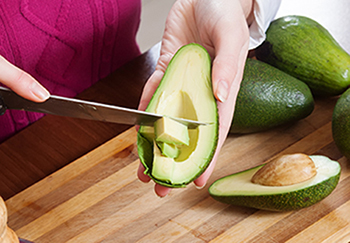
If you pay any attention to fad diets, you’ve probably heard about the ketogenic diet before. What you probably didn’t know is that variations of the ketogenic diet can be used to treat epilepsy for patients whose seizures aren’t well managed with medication. I sat down with Diana Gulotta, a registered dietitian with UVA Neurology’s Ketogenic Diet Therapy Program, to learn how it works.
Ketogenic, Ketosis and Ketones, Oh My!
First, let’s get some terminology out of the way. Ketogenic refers to the diet putting the body into ketosis. Ketosis describes the state of the body when it’s producing ketones. These result from burning fat for energy.
The body generally uses carbohydrates as its energy source. When deprived of carbs, it switches over to burning fat instead. While the typical American diet includes 200-300 grams of carbohydrates per day, a patient on a medical ketogenic diet may be restricted to a mere 10-15 grams per day to ensure they achieve and maintain the state of ketosis.
UVA Health’s neurology department uses two variations of the medical ketogenic diet for epilepsy: the classic ketogenic diet and the modified Atkins diet. Both of these diets emphasize high-fat foods while restricting carbohydrates and providing adequate but not excessive amounts of protein. The medical versions of these diets are much stricter than the mainstream ketogenic and Atkins diets.
Seizure Reduction
There is a relatively well-known case about a boy named Charlie, whose parents tried the ketogenic diet as a last resort to treat his seizures. Charlie’s story was the basis of the 1997 film “…First Do No Harm.” Charlie was having multiple seizures a day, uncontrolled by medication. He became completely seizure-free on the medical ketogenic diet. His family went on to create The Charlie Foundation, which promotes the ketogenic diet for epilepsy treatment.
Medical ketogenic diets don’t work for all patients who try them, but according to Gulotta:
- 50 to 60 percent of patients achieve a 50-percent reduction in seizures.
- About 10 percent become seizure-free.
It can take several weeks to several months to know if the diet will work for a patient.
How the Ketogenic Diet Reduces Epileptic Seizures
When I asked how the ketogenic diet was able to reduce seizures, Gulotta answered, “If you found that out, you’d be famous.”
The medical community doesn’t yet know definitively why the ketogenic diet reduces seizures. But there are many theories. According to Gulotta, it’s related to the brain chemistry that results from using ketones instead of glucose (energy created from breaking down carbohydrates) for energy. There’s a lot of research going on about why the ketogenic diet can reduce seizures.
Who Can Benefit from a Ketogenic Diet for Epilepsy Treatment
Most patients who begin a medical ketogenic diet have medically refractory epilepsy. That means they’ve tried at least two medications without result. Patients with Lennox-Gastaut syndrome (a type of epilepsy characterized by multiple types of seizures and, often, impaired intellectual development) are frequently good candidates for a ketogenic diet. That’s because Lennox-Gastaut can be particularly difficult to manage with medications.
A medical ketogenic diet is the primary treatment for patients with GLUT-1 Deficiency Syndrome or Pyruvate Dehydrogenase Syndrome (both are glucose metabolism disorders that can result in seizures and other dangerous side effects).
Sometimes neurologists can’t be sure what type of seizures a patient is having, which makes finding effective medication harder. A medical ketogenic diet can be an effective solution for these patients, too.
Life on the Diet
The main component of a medical ketogenic diet is high-fat, low-carb foods such as:
- Heavy cream (regular milk is too high in carbs)
- Avocado
- Butter
- Small amounts of chicken
- Oils
- Certain nuts
- Mayonnaise
Vegetables are only allowed in very small servings, and only if they’re low-carb. While most vegetables are pretty low in carbs, the small amounts add up quickly. And the carbohydrate allowance on keto is very small.
Soda, juice, grains, bread and mainstream desserts are not allowed. Certain fruits are allowed, but only in extremely small amounts.
The accuracy of the carbohydrate-to-fat ratio is so important that patients on the medical ketogenic diet for epilepsy must weigh their food using a gram-based scale rather than a typical ounce-based scale or cup measure. They even can’t use certain personal hygiene products, since some contain carbohydrates, and carbohydrates can be absorbed through the skin.
The Atkins Diet: A Less-Restrictive Option
The modified Atkins diet is slightly less-restrictive than the classic ketogenic diet. It focuses on net carbs, where fiber offsets carbohydrates. It produces the same results as the classic ketogenic diet — reducing seizures through ketosis — when followed correctly. Gulotta tends to steer picky eaters and adult patients toward the modified Atkins ketogenic diet.
Medication While on the Diet
Almost all patients remain on at least one seizure medication, but doctors can often reduce the number of medications and/or dosages once the patient is seeing success with the diet.
Patients also receive a variety of supplements to ensure their nutritional needs are met. Doctors regularly check the vitamin, mineral, and electrolyte levels of patients following the diet.
Should you try the ketogenic diet for epilepsy treatment?
Make an appointment with the Ketogenic Diet Clinic.
Long-Term Results
Typically, if a patient has been on the diet for 2-3 years with well-controlled seizures, the care team will begin discussing taking the patient off the diet.
In fact, according to Gulotta, most patients continue to see the same level of seizure reduction after stopping the diet. Suddenly breaking ketosis can be dangerous, so the patient is weaned off gradually. This happens under close medical supervision, over a period of 2-4 months.
Determining if a Ketogenic Diet is Right for a Patient
If you or your family thinks the ketogenic diet seems like a viable treatment option, your current neurologist is generally the best place to start. That neurologist may refer you to UVA Health Neurology for a consultation.
Keep in mind that there are potential side effects. A medical ketogenic diet should only be followed under close medical supervision.


Atkins restricts “net carbs”, or carbs that have an effect on blood sugar. Net carbohydrates can be calculated from a food source by subtracting sugar alcohols and fiber (which are shown to have a negligible effect on blood sugar levels) from total carbohydrates. Sugar alcohols need to be treated with caution because while they may be slower to convert to glucose, they can be a significant source of glycemic load and can stall weight loss.